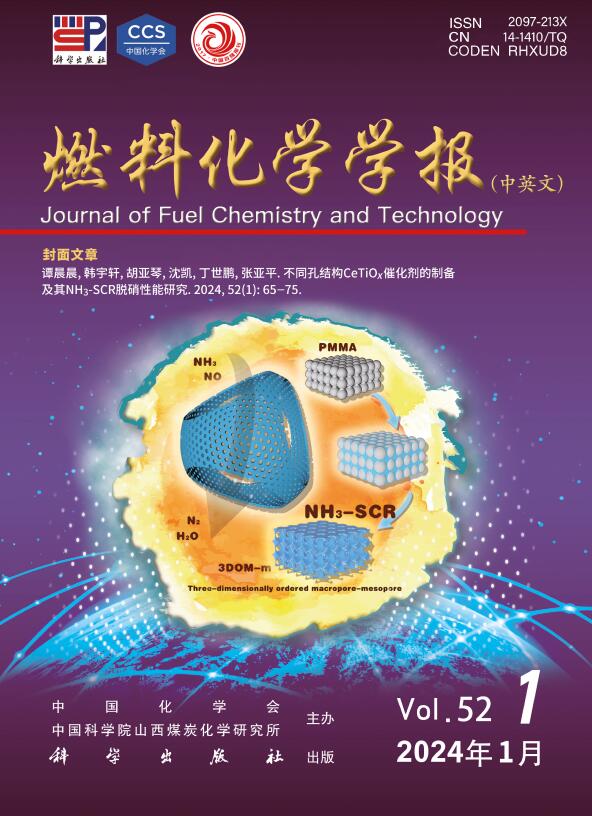Direct liquefaction behavior of Shenhua Shangwan coal under CO containing atmosphere
Q3 Energy
引用次数: 0
Abstract
Direct coal liquefaction (DCL) under CO or syngas atmosphere is beneficial to reduce the cost of hydrogen production. Effects of CO on liquefaction process of Shangwan coal were investigated by comparing the liquefaction behavior in three atmospheres of CO, H2, and N2. Then, effects of different CO/H2 ratios and catalysts on the liquefaction process in syngas were investigated. The results indicated that the oil yield under CO atmosphere reached 43.1%, which was 4.2% lower than that under H2, but 10.2% higher than that under N2. The liquefaction performance was further improved by adding the Shenhua 863 catalyst. It is analyzed that CO promoted liquefaction in two ways: water-gas shift reaction and the reaction between CO and organic structures of coal. Through characterization of the products by GC-MS and FT-IR, it was found that CO makes benzenes, aliphatics, and oxygen-containing compounds in liquefied oil simultaneously increased. The effect on functional groups and free radicals concentration in the solid products was not obvious. The experimental results under syngas showed that the highest oil yield, 57.4%, can be obtained in DCL with 20% CO syngas, and further improved by increasing moisture content of coal appropriately. In addition, the Shenhua 863 catalyst had a good catalytic effect on the liquefaction process and also water-gas shift reaction.
神华上湾煤在含 CO 大气环境下的直接液化行为
在 CO 或合成气气氛下进行煤直接液化(DCL)有利于降低制氢成本。通过比较 CO、H2 和 N2 三种气氛下的液化行为,研究了 CO 对上湾煤液化过程的影响。然后,研究了不同 CO/H2 比率和催化剂对合成气液化过程的影响。结果表明,CO气氛下的产油率达到43.1%,比H2气氛下低4.2%,但比N2气氛下高10.2%。加入神华 863 催化剂后,液化性能进一步提高。据分析,CO 促进液化的方式有两种:水煤气变换反应和 CO 与煤的有机结构反应。通过 GC-MS 和 FT-IR 对产物的表征发现,CO 使液化油中的苯类、脂肪族和含氧化合物同时增加。对固体产物中官能团和自由基浓度的影响并不明显。合成气条件下的实验结果表明,在使用 20% CO 合成气的 DCL 中,可获得最高的出油率(57.4%),并可通过适当提高煤的含水率进一步提高出油率。此外,神华 863 催化剂对液化过程和水煤气变换反应均有良好的催化效果。
本文章由计算机程序翻译,如有差异,请以英文原文为准。
求助全文
约1分钟内获得全文
求助全文
来源期刊

燃料化学学报
Chemical Engineering-Chemical Engineering (all)
CiteScore
2.80
自引率
0.00%
发文量
5825
期刊介绍:
Journal of Fuel Chemistry and Technology (Ranliao Huaxue Xuebao) is a Chinese Academy of Sciences(CAS) journal started in 1956, sponsored by the Chinese Chemical Society and the Institute of Coal Chemistry, Chinese Academy of Sciences(CAS). The journal is published bimonthly by Science Press in China and widely distributed in about 20 countries. Journal of Fuel Chemistry and Technology publishes reports of both basic and applied research in the chemistry and chemical engineering of many energy sources, including that involved in the nature, processing and utilization of coal, petroleum, oil shale, natural gas, biomass and synfuels, as well as related subjects of increasing interest such as C1 chemistry, pollutions control and new catalytic materials. Types of publications include original research articles, short communications, research notes and reviews. Both domestic and international contributors are welcome. Manuscripts written in Chinese or English will be accepted. Additional English titles, abstracts and key words should be included in Chinese manuscripts. All manuscripts are subject to critical review by the editorial committee, which is composed of about 10 foreign and 50 Chinese experts in fuel science. Journal of Fuel Chemistry and Technology has been a source of primary research work in fuel chemistry as a Chinese core scientific periodical.
 求助内容:
求助内容: 应助结果提醒方式:
应助结果提醒方式:


